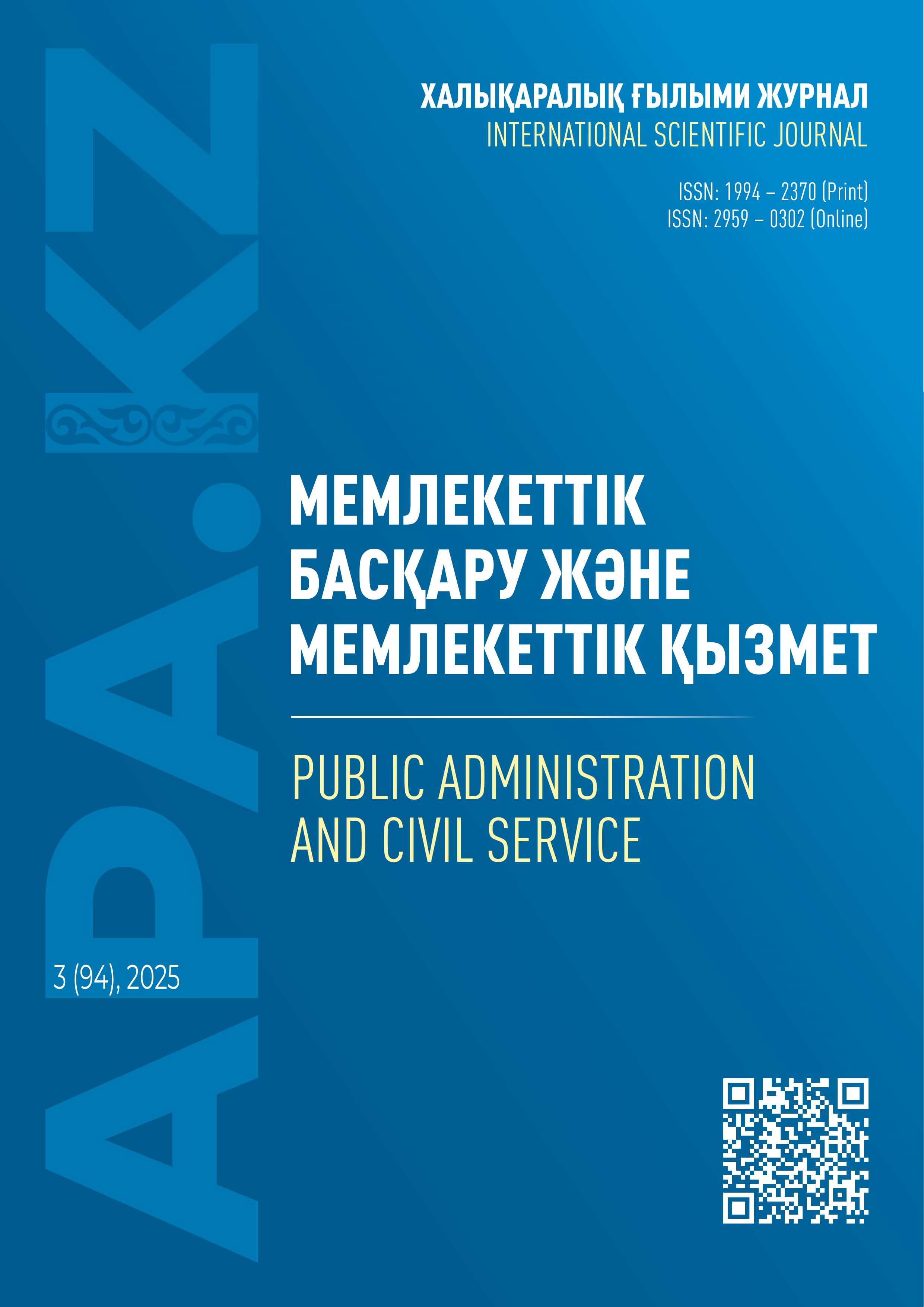ӨЗГЕРІС КЕЗЕҢІНДЕГІ МЕМЛЕКЕТТІК ҚЫЗМЕТ: ЕҢБЕКАҚЫНЫҢ ӘДІЛДІГІ, МАНСАП АЙҚЫНДЫҒЫ ЖӘНЕ ҚАЗАҚСТАНДЫҚ МЕМЛЕКЕТТІК ҚЫЗМЕТШІЛЕРДІҢ ҰЙЫМДЫҚ АДВОКАЦИЯСЫ
DOI:
https://doi.org/10.52123/1994-2370-2025-1513Кілт сөздер:
Public Service Motivation; Job Satisfaction; Civil-Service Reform; Kazakhstan; RetentionАңдатпа
Бұл зерттеу – Қазақстан мемлекеттік қызметкерлерінің мотивациялық тетіктерін, жұмысқа қанағаттануын және реформалық басымдықтарын бүкіл республика бойынша алғаш рет аралас әдіспен сипаттайтын еңбек. 2025 жылдың наурыз–сәуір айларында бес экономикалық өңір мен бес министрліктен 886 қызметкерді қамтыған мақсатты-қабатталған сауалнама Public Service Motivation (PSM) шкаласын, Жұмысқа қанағаттану индексін, ұйымдық климат көрсеткіштерін және қызметкерлердің Net Promoter Score (eNPS) өлшемін растаған сандық құралдарды ашық сұрақпен үйлестірді. Деректерге көп айнымалы регрессиялық талдау және тақырыптық кодтау қолданылды. Мемқызметке келу себептері ішінде жұмыс орнының тұрақтылығы (63 %) мен қоғам игілігіне үлес қосу тілегі (49 %) басым, бұл инструменталдық және альтруистік уәждердің қатар өмір сүретінін көрсетеді. Басшылық қолдауы мен еңбек жағдайлары жалпы қанағаттануға елеулі әсер етеді (β = 0,34 және 0,27, p < 0,01), ал мансаптық мүмкіндіктер – қызметкерлерді ұстаудың негізгі тетігі (β = 0,41, p < 0,001). Айлыққа көңіл толмау жеке секторға ауысу ықтималдығын үш есеге арттырады (OR = 2,8). Жоғары білім деңгейіне (магистр дәрежесі – 18 %) қарамастан, респонденттердің тек 27 %-ы ұйымның «промоутері», нәтижесінде eNPS +6 ғана, бұл адвокацияның әлсіздігін аңғартады. Гендерлік және буындық айырмашылықтар айқын: әйелдердің адалдығы жоғары (+10 eNPS-ұпай), ал 30 жасқа дейінгі қызметкерлердің шығып кету ниеті ең үлкен. Сапалық деректер ең өзекті кемшіліктер ретінде мардымсыз жалақы, күйзеліс (burnout) пен мансаптағы ашықтықтың жоқтығын көрсетеді; ұсынылған шешімдер көбіне технократиялық сипатта (цифрландыру, тарифтік сеткалар) болып, қатынастық легитимдікті елемейді. PSM теориясын eNPS өлшемімен ұштастыра отырып, мақала посткеңестік контексте мотивацияны зерттеуді кеңейтеді және кадр тұрақтылығын қамтамасыз ету үшін саясат тетіктерін – еңбекақыны қайта қарау, меритократиялық ілгерілеу және «коуч-менеджер» моделін – айқындайды.
Сілтемелер
Perry J. L., Wise L. R. (1990). The Motivational Bases of Public Service. Public Administration Review, 50 (3), 367–373. https://doi.org/10.2307/976618
Karini A. (2024). Politico-Administrative Culture and Public Service Reform in Post-Independence Kazakhstan. Administrative Sciences, 14 (10), 268. https://doi.org/10.3390/admsci14100268
OECD. (2018). Benchmarking Civil Service Reform in Kazakhstan. OECD Public Governance Reviews. Paris: OECD Publishing. https://doi.org/10.1787/9789264288096-en
Maslow, A. H. (1943). A theory of human motivation. Psychological Review, 50(4), 370–396. https://doi.org/10.1037/h0054346
Herzberg F., Mausner B., Snyderman B. B. (1959). The Motivation to Work (2-е изд.). New York: John Wiley & Sons.
Vroom V. H. (1964). Work and Motivation. New York: John Wiley & Sons.
Deci E. L., Ryan R. M. (2000). Self-Determination Theory and the Facilitation of Intrinsic Motivation, Social Development, and Well-Being. American Psychologist, 55 (1), 68–78. https://doi.org/10.1037/0003-066X.55.1.68
Meyer-Sahling J.-H., Mikkelsen K. S. (2016). Civil Service Laws, Merit, and Motivation: Evidence from a Survey of Personnel Policies in Post-Communist Europe. Public Administration, 94 (4), 1105–1123. https://doi.org/10.1111/padm.12274
Spector P. E. (1997). Job Satisfaction: Application, Assessment, Causes, and Consequences. Thousand Oaks, CA: Sage.
OECD. (2025). Public Governance Scan of Kazakhstan. Paris: OECD Publishing.
Mussagulova A., Chen C.-A., Ritz A. (2023). Are Autonomy and Intrinsic Motivation of Public Servants Lower in Post-Communist States? Public Performance & Management Review, 46 (5), 1237–1265. https://doi.org/10.1080/15309576.2023.2243246
Sabdenov R., Abdrakhmanova G., Pussyrmanov N. (2025). Assessing the Integration of Digital Competencies into Civil Service Recruitment and Training in Kazakhstan. Problems and Perspectives in Management, 23 (2), 561–571. https://doi.org/10.21511/ppm.23(2).2025.40
Agency of the Republic of Kazakhstan for Civil Service Affairs. (2025). National Report on the State of the Civil Service of the Republic of Kazakhstan (in Russian). https://www.gov.kz/memleket/entities/qyzmet/documents/details/825723?lang=ru
Astana Civil Service Hub (ACSH). (2024). e-HRM Systems for the Civil Service in Kazakhstan, Kyrgyzstan, Uzbekistan, and the Republic of Korea. UNDP & ACSH. https://www.undp.org/kazakhstan/publications/e-hrm-systems-civil-service-kazakhstan-kyrgyzstan-uzbekistan-and-republic-korea
Rollnik-Sadowska E., Slavković M., Bercu A.-M., Bugarčić M. (2023). Public Service Motivation and Job Satisfaction: The Role of Social Support during Crisis. Equilibrium. Quarterly Journal of Economics and Economic Policy, 18 (4), 1179–1215. https://doi.org/10.24136/eq.2023.037
Issenova G., Bokayev B., Nauryzbek M., et al. (2024). An Examination of Civil Servants’ Assessment of the New Civil Service Reforms in Kazakhstan. Central European Journal of Public Policy, 18 (2), 2–16. https://doi.org/10.2478/cejpp-2024-0006
Cronbach L. J. (1951). Coefficient Alpha and the Internal Structure of Tests. Psychometrika, 16 (3), 297–334. https://doi.org/10.1007/BF02310555
Hosmer D. W., Lemeshow S. (2000). Applied Logistic Regression (2-е изд.). New York: John Wiley & Sons.
QSR International. (2024). NVivo 14 Qualitative Data Analysis Software [Computer software].
Reichheld F. F. (2003). The One Number You Need to Grow. Harvard Business Review, 81 (12), 46–54.
Rothstein B. (2011). The Quality of Government: Corruption, Social Trust, and Inequality in International Perspective. Chicago: University of Chicago Press.
Bandura A. (1999). Moral Disengagement in the Perpetration of Inhumanities. Personality and Social Psychology Review, 3 (3), 193–209. https://doi.org/10.1207/s15327957pspr0303_3
Boudreau J. W., Ramstad P. M. (2007). Beyond HR: The New Science of Human Capital. Boston: Harvard Business School Press.
Ackerman M. S. (2000). The Intellectual Challenge of CSCW: The Gap Between Social Requirements and Technical Feasibility. Human–Computer Interaction, 15 (2), 179–203. https://doi.org/10.1207/S15327051HCI1523_5
Rousseau D. M. (1995). Psychological Contracts in Organizations: Understanding Written and Unwritten Agreements. Thousand Oaks, CA: Sage.
Dillman D. A., Smyth J. D., Christian L. M. (2009). Internet, Mail, and Mixed-Mode Surveys: The Tailored Design Method. Hoboken: John Wiley & Sons.
Podsakoff P. M., MacKenzie S. B., Lee J.-Y., Podsakoff N. P. (2003). Common Method Biases in Behavioral Research: A Critical Review of the Literature and Recommended Remedies. Journal of Applied Psychology, 88 (5), 879–903. https://doi.org/10.1037/0021-9010.88.5.879
Schaufeli W. B., Leiter M. P., Maslach C. (2009). Burnout: 35 Years of Research and Practice. Career Development International, 14 (3), 204–220. https://doi.org/10.1108/13620430910966406
Hofstede G. (2001). Culture’s Consequences: Comparing Values, Behaviors, Institutions and Organizations Across Nations (2-е изд.). Thousand Oaks, CA: Sage.
##submission.additionalFiles##
Жарияланды
Дәйексөз келтіру үлгісі
Журналдың саны
Бөлім
Лицензия

Берілген жұмыс келесілерге сәйкес лицензияланады Creative Commons Attribution-NonCommercial-NoDerivatives 4.0 International License.





